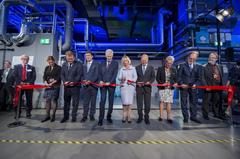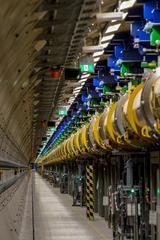URL: https://www.desy.de/news/news_search/index_eng.html
Breadcrumb Navigation
DESY News: International X-ray laser European XFEL inaugurated
News
News from the DESY research centre
International X-ray laser European XFEL inaugurated
European XFEL, the largest and most powerful X-ray laser in the world, was officially inaugurated today in an international event with musical and enlightening highlights. Research ministers and other prominent guests from across Europe joined the European XFEL Managing Directors to officially start the research operation of the facility with the first two experiments.

Ribbon cutting in the experimental hall. Credit: European XFEL
European XFEL Managing Director Prof. Dr. Robert Feidenhans’l said: “We are proud to be opening the strongest X-ray laser in the world and start doing science together with our user community. The European XFEL is a unique facility that will open the door to new areas of science.”
Prof. Dr. Helmut Dosch, Chairman of the DESY Board of Directors, said: “What started as a vision and was set in motion at DESY more than 20 years ago has now become a reality: the world’s most powerful laser for X-ray light. Now scientists from around the world will conduct research at this most advanced high-speed camera for the nanocosmos in the world, and I wish them many exciting results – both fundamental and revolutionary.”

View into the tunnel with the superconducting linear accelerator of European XFEL (photo: DESY/D. Nölle).
Prof. Dr. Andrei Fursenko, Aide to the President of the Russian Federation and former Research Minister, said: “This international research megaproject is our common intellectual contribution to the world of science. Many young people from different countries work on this project, which testifies that this project is designed for the future.”
The French Minister of Higher Education, Research and Innovation, Prof. Dr. Frédérique Vidal, said: “The European XFEL is a great illustration of Europe’s leading role in the international competition and of the know-how of its industrial players in building top-level scientific instruments. France and its European partners are fully engaged in reinforcing and developing large-scale research infrastructure and making it a shared goal in the construction of the European Research Area.”
Mayor Scholz said: “With the European XFEL, scientists will forge ahead into unknown worlds and help to find answers to questions facing humanity that will make life on our planet better. The European XFEL is a joint scientific project in the spirit of the Enlightenment and of international cooperation, and a promising example of European integration in action and of the success of European research funding.”
Scientists from across the world will come to European XFEL to do their research by applying for access to the instruments via a selection process. The assignment of the so-called beamtime, of generally one or two weeks per group and experiment, is awarded according to the scientific excellence of the submitted proposals.
Together with Minister Johanna Wanka, Hamburg’s First Mayor Olaf Scholz, and Schleswig Holstein’s Minister of Education, Science and Cultural Affairs Karin Prien, European XFEL Managing Director Robert Feidenhans’l greeted the first external researchers of the new international research facility on stage. Scientists and their guests are currently busy preparing for the first user experiments at the facility, which will begin in mid-September.
Dr. Mauro Dell’Ambrogio, State Secretary for Education, Research, and Innovation of Switzerland, said: “Today, 11 countries showed that together they are able to build a very complicated, very expensive facility dedicated to science, and all of this in record time and within budget. European XFEL is a new landmark in the worldwide scientific landscape that opens up a brand-new spectrum of possible experiments.”
Prof. Dr. Łukasz Szumowski, Polish Deputy Minister of Science and Education, said: “The 3.4-kilometre-long underground X-ray laser is truly state-of-the-art. What is important is that it will contribute not only to basic science but also to practical applications, e.g. in materials science, biology and even medicine, which is close to my heart.”
Minister Prien said: “The inauguration of this worldwide unique X-ray laser is a great moment for the scientific community, the European XFEL Council and member countries, for Germany and, of course, for Hamburg and Schleswig-Holstein. The billion-euro project marks a new era in fundamental research and will also deliver enormous impulses for many applications – a major location for science of international standing has been created in Schenefeld.”
Europen XFEL scientists subsequently informed Minister Wanka and her guests about the experiments at the first two instruments in the underground experiment hall: the instrument FXE (Femtosecond X-Ray Experiments), which will enable the study of fast reactions and be able to record molecular movies, and the instrument SPB/SFX (Single Particles, Clusters, and Biomolecules and Serial Femtosecond Crystallography) developed for investigating the structure and transformation of biomolecules and other biological particles, such as viruses and cell components.
At the FXE instrument, scientists explained the guests how the first European XFEL’s first snapshots of a chemical reaction will be done. The reaction will be triggered by an ultrashort pulse of visible light, while an X-ray flash, timed to reach the sample after the reaction is triggered, records the state of the molecule at that moment in time. During this first experiment, reacting molecules will be studied in a watery environment in order to learn more about the influence of water on the reaction itself.
At the SPB/SFX instrument, the guests pressed the button to start the first ever experiment at European XFEL to determine the structure of a biomolecule. With this model experiment, the structure is already known, allowing the researchers to, for example, check whether the X-ray laser and the instruments are optimally coordinated. The first sample with unknown structure will come with users when they arrive for experiments at the facility in mid-September.
Already every evening from 28 August, laser light beams can be seen shining across Hamburg from the Elbphilharmonie, Hamburg University, HAW Hamburg, the Hamburg Ministry of Science, Research and Equalities, and the Planetarium to European XFEL in Schenefeld as the City of Hamburg welcomes the international research facility to the metropolitan area. From 1 to 3 September, the laser installation will turn from green to blue as it merges with the Blue Port Hamburg installation.



